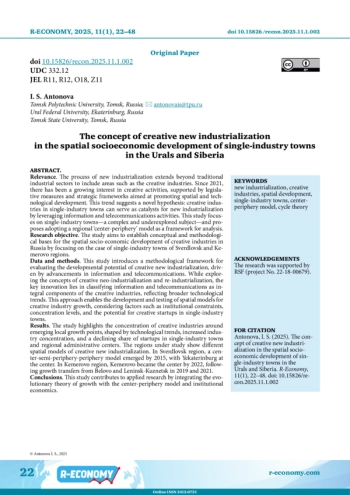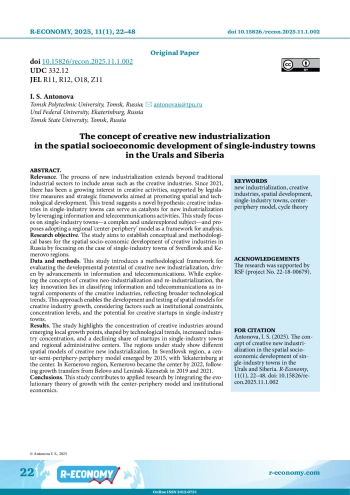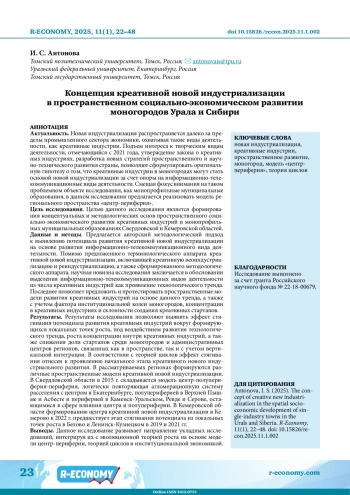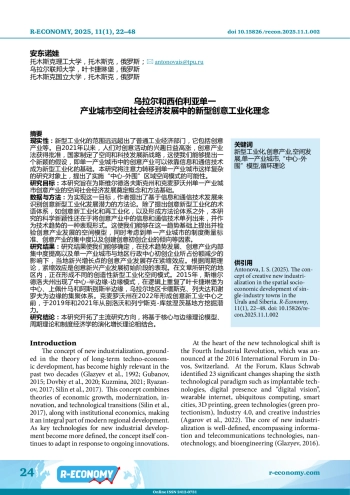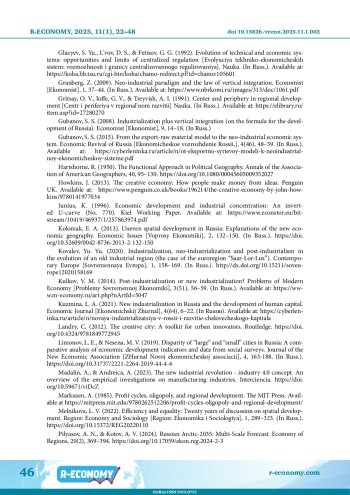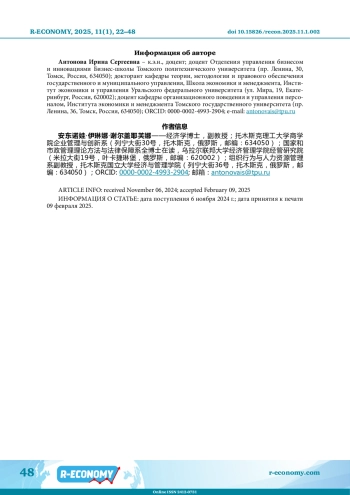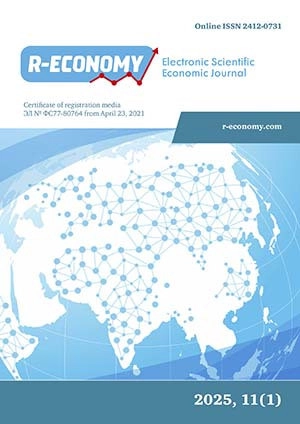Relevance. The process of new industrialization extends beyond traditional industrial sectors to include areas such as the creative industries. Since 2021, there has been a growing interest in creative activities, supported by legislative measures and strategic frameworks aimed at promoting spatial and technological development. This trend suggests a novel hypothesis: creative industries in single-industry towns can serve as catalysts for new industrialization by leveraging information and telecommunications activities. This study focuses on single-industry towns-a complex and underexplored subject-and proposes adopting a regional ‘center-periphery’ model as a framework for analysis. Research objective. The study aims to establish conceptual and methodological bases for the spatial socio-economic development of creative industries in Russia by focusing on the case of single-industry towns of Sverdlovsk and Kemerovo regions. Data and methods. This study introduces a methodological framework for evaluating the developmental potential of creative new industrialization, driven by advancements in information and telecommunications. While exploring the concepts of creative neo-industrialization and re-industrialization, the key innovation lies in classifying information and telecommunications as integral components of the creative industries, reflecting broader technological trends. This approach enables the development and testing of spatial models for creative industry growth, considering factors such as institutional constraints, concentration levels, and the potential for creative startups in single-industry towns. Results. The study highlights the concentration of creative industries around emerging local growth points, shaped by technological trends, increased industry concentration, and a declining share of startups in single-industry towns and regional administrative centers. The regions under study show different spatial models of creative new industrialization. In Sverdlovsk region, a center-semi-periphery-periphery model emerged by 2015, with Yekaterinburg at the center. In Kemerovo region, Kemerovo became the center by 2022, following growth transfers from Belovo and Leninsk-Kuznetsk in 2019 and 2021. Conclusions. This study contributes to applied research by integrating the evolutionary theory of growth with the center-periphery model and institutional economics.
Идентификаторы и классификаторы
The concept of new industrialization, grounded in the theory of long-term techno-economic development, has become highly relevant in the past two decades (Glazyev et al., 1992; Gubanov, 2015; Dovbiy et al., 2020; Kuzmina, 2021; Ryazanov, 2017; Silin et al., 2017). This concept combines theories of economic growth, modernization, innovation, and technological transitions (Silin et al., 2017), along with institutional economics, making it an integral part of modern regional development. As key technologies for new industrial development become more defined, the concept itself continues to adapt in response to ongoing innovations.
Список литературы
1. Abankina T. V. (2022). Creative economy in Russia: New trends. Journal of the New Economic Association, 54(2), 221-228. https://doi.org/10.31737/2221-2264-2022-54-2-13.
2. Agarkov G. A., Berg D. B., Belyaeva Zh. S., Gorodnova N. V., Drapkin I. M., Krivorotov V. V., Drapkin I. M., Krivorotov V. V., Novokshonova Z. V., Savostina O. V., Talimova G. U., Turgel I. D., Usoltseva A. A. (2022). Mechanisms for regulating economic processes in the context of digital transformation: International, national, regional levels [Mekhanizmy regulirovaniya ekonomicheskih processov v usloviyah cifrovoj transformacii: mezhdunarodnyj, nacional’nyj, regional’nyj urovni]. Ural University Publishing House. (In Russ.). Available at: http://elar.urfu.ru/handle/10995/116471.
3. Antonova I. S., Maleeva E. A. (2024). Assessing the development potential of creative businesses in “second-tier” cities. Economy of Region [Ekonomika Regiona], 3, 671-685. (In Russ.) https://doi.org/10.17059/ekon.reg.2024-3-5.
4. Bekhterev D. V. (2019). Life cycle theories in the management of single-industry towns. Problems of Socio-Economic Development of Siberia [[Problemy Social’no-Ekonomicheskogo Razvitiya Sibiri], 1, 23-28. (In Russ.). Available at: https://elibrary.ru/item.asp?id=39209086.
5. Cadot O., Carrère C., Strauss-Kahn V. (2011). Export diversification: what’s behind the hump? Review of Economics and Statistics, 93(2), 590-605. https://doi.org/10.1162/REST_a_00078.
6. Capello R., Cerisola S. (2023). Regional reindustrialization patterns and productivity growth in Europe. Regional Studies, 57(1), 1-12. https://doi.org/10.1080/00343404.2022.2050894.
7. Chang T.-C., Lyu Y., Chang T., Ranjbar O., Saboori B. (2024). Diversifying the export basket of creative products and accelerating economic growth. The Journal of International Trade & Economic Development, 1-20. https://doi.org/10.1080/09638199.2024.2323047.
8. Dovbiy I. P., Degtyarenko A. N., Kobylyakova V. V. (2020). “New industrialization” in Russia as a factor of transition to a “green” economy. Financial Journal [Finansovyj Zhurnal], 12(4), 85-100. (In Russ.). http://doi.org/10.31107/2075-1990-2020-4-85-100.
9. Eisenstadt S. (1981). Cultural Orientations and Center-Periphery in Europe in a Comparative Perspective. In P. T. B. U. Irvington-on-Hudson (Ed.), Mobilization, CenterPeriphery Structures and Nation-Building: a Volume in Commemoration of Stein Rokkan. Columbia University Press. Available at: https://catalog.hathitrust.org/Record/000167680.
10. Feng T. (2022). New Industrial Innovation Cooperation. In The Routledge Handbook of the Belt and Road (pp. 375-380). Routledge. https://doi.org/10.4324/9781003286202-81.
11. Friedmann J. A. (1967). A general theory of polarized development. Available at: https://repositorio.cepal.org/bitstream/handle/11362/34953/S6700361_en.pdf.
12. Glazyev S. (2016). World economic structures in global economic development. Economics and Mathematical Methods [Ekonomika i Matematicheskie Metody], 2, 3-29. (In Russ.). Available at: https://ideas.repec.org/a/scn/cememm/v52y2016i2p3-29.html.
13. Glazyev S. Yu. (2010). Strategy of advanced development of Russia in the context of the global crisis: monograph [Strategiya operezhayushchego razvitiya Rossii v usloviyah global’nogo krizisa: monografiya] (In Russ.). Available at: http://ukros.ru/wp-content/uploads/2017/08/1-2.pdf.
14. Glazyev S. Yu. (2014). Eurasian union - shield from sanctions. Eurasian Integration: Economics, Law, Politics [Evrazijskaya Integraciya: Ekonomika, Pravo, Politika], 16, 5-6. (In Russ.). Available at: https://cyberleninka.ru/article/n/evraziyskiy-soyuz-schit-ot-sanktsiy.pdf.
15. Glazyev S. Yu. (2016). The last world war. The United States starts and loses [Poslednyaya mirovaya vojna. SSHA nachinayut i proigryvayut] (In Russ.). Available at: https://www.litres.ru/book/sergey-urevich-glaze/poslednyaya-mirovaya-voyna-ssha-nachinaut-i-proigryva-21431473/.
16. Glazyev S. Yu., Ayvazov, A. E., & Belikov, V. A. (2019). Cyclically-wave theories of economic development and prospects of the world economy. Is medium-term and long-term development of the world economy predictable? Scientific Works of the Free Economic Society of Russia [Nauchnye Trudy Vol’nogo Ekonomicheskogo Obshchestva Rossii], 19(5), 177-211. (In Russ.). Available at: https://cyberleninka.ru/article/n/tsiklicheski-volnovye-teorii-ekonomicheskogo-razvitiya-i-perspektivy-mirovoy-ekonomiki-predskazuemo-li-srednesrochnoe-i-dolgosrochn.
17. Glazyev S. Yu., L’vov, D. S., & Fetisov, G. G. (1992). Evolution of technical and economic systems: opportunities and limits of centralized regulation [Evolyuciya tekhniko-ekonomicheskih sistem: vozmozhnosti i granicy centralizovannogo regulirovaniya]. Nauka. (In Russ.). Available at: https://koha.lib.tsu.ru/cgi-bin/koha/chamo-redirect.pl?id=chamo:105601.
18. Granberg Z. (2009). Neo-industrial paradigm and the law of vertical integration. Economist [Ekonomist], 1, 37-44. (In Russ.). Available at: https://www.nbrkomi.ru/images/313/doc/1061.pdf.
19. Gritsay O. V., Ioffe G. V., Treyvish A. I. (1991). Center and periphery in regional development [Centr i periferiya v regional’nom razvitii] Nauka. (In Russ.). Available at: https://elibrary.ru/item.asp?id=27280270.
20. Gubanov S. S. (2008). Industrialization plus vertical integration (on the formula for the development of Russia). Economist [Ekonomist], 9, 14-18. (In Russ.).
21. Gubanov S. S. (2015). From the export-raw material model to the neo-industrial economic system. Economic Revival of Russia [Ekonomicheskoe vozrozhdenie Rossii,], 4(46), 48-59. (In Russ.). Available at: https://cyberleninka.ru/article/n/ot-eksportno-syrievoy-modeli-k-neoindustrialnoy-ekonomicheskoy-sisteme.pdf.
22. Hartshorne R. (1950). The Functional Approach in Political Geography. Annals of the Association of American Geographers, 40, 95-130. https://doi.org/10.1080/00045605009352027.
23. Howkins J. (2013). The creative economy: How people make money from ideas. Penguin UK. Available at: https://www.penguin.co.uk/books/196214/the-creative-economy-by-john-howkins/9780141977034.
24. Junius K. (1996). Economic development and industrial concentration: An inverted U-curve (No. 770). Kiel Working Paper. Available at: https://www.econstor.eu/bitstream/10419/46937/1/257863974.pdf.
25. Kolomak E. A. (2013). Uneven spatial development in Russia: Explanations of the new economic geography. Economic Issues [Voprosy Ekonomiki], 2, 132-150. (In Russ.). https://doi.org/10.32609/0042-8736-2013-2-132-150.
26. Kovalev Yu. Yu. (2020). Industrialization, neo-industrialization and post-industrialism in the evolution of an old industrial region (the case of the euroregion “Saar-Lor-Lux”). Contemporary Europe [Sovremennaya Evropa], 1, 158-169. (In Russ.). http://dx.doi.org/10.15211/soveurope12020158169.
27. Kulkov V. M. (2014). Post-industrialization or new industrialization? Problems of Modern Economy [Problemy Sovremennoj Ekonomiki], 3(51), 56-59. (In Russ.). Available at: https://www.m-economy.ru/art.php?nArtId=5047.
28. Kuzmina L. A. (2021). New industrialization in Russia and the development of human capital. Economic Journal [Ekonomichskij Zhurnal], 4(64), 6-22. (In Russю). Available at: https://cyberleninka.ru/article/n/novaya-industrializatsiya-v-rossii-i-razvitie-chelovecheskogo-kapitala.
29. Landry C. (2012). The creative city: A toolkit for urban innovators. Routledge. https://doi.org/10.4324/9781849772945.
30. Limonov L. E., Nesena M. V. (2019). Disparity of “large” and “small” cities in Russia: A comparative analysis of economic development indicators and data from social surveys. Journal of the New Economic Association [ZHurnal Novoj ekonomicheskoj associacii], 4, 163-188. (In Russ.). https://doi.org/10.31737/2221-2264-2019-44-4-6.
31. Madalin A., Andreica A. (2023). The new industrial revolution - industry 4.0 concept. An overview of the empirical investigations on manufacturing industries. Interciencia. https://doi.org/10.59671/viDcZ.
32. Markusen A. (1985). Profit cycles, oligopoly, and regional development. The MIT Press. Available at https://mitpress.mit.edu/9780262512206/profit-cycles-oligopoly-and-regional-development/.
33. Melnikova L. V. (2022). Efficiency and equality: Twenty years of discussion on spatial development. Region: Economy and Sociology [Region: Ekonomika i Sociologiya], 1, 289-323. (In Russ.). https://doi.org/10.15372/REG20220110.
34. Pilyasov A. N., Kotov A. V. (2024). Russian Arctic-2035: Multi-Scale Forecast. Economy of Regions, 20(2), 369-394. https://doi.org/10.17059/ekon.reg.2024-2-3.
35. Polterovich V. M. (2007). On the strategy of catching-up development for Russia. Economic Science of Modern Russia [Ekonomicheskaya Nauka Sovremennoj Rossii], 3, 17-23. (In Russ.). Available at: https://cyberleninka.ru/article/n/o-strategii-dogonyayuschego-razvitiya-dlya-rossii.
36. Polterovich V. M., Popov V. V. (2005). Stimulation of growth and stages of development. Modernization of the Economy and Cultivation of Institutions [Modernizaciya Ekonomiki i Vyrashchivanie Institutov], 2, 137-149. (In Russю). Available at: https://pages.nes.ru/vpopov/documents/Stages-Yasin2005Russian.pdf.
37. Potts J. (2009). Why creative industries matter to economic evolution. Economics of Innovation and New Technology, 18(7), 663-673. https://doi.org/10.1080/10438590802564592.
38. Ryazanov, V. T. (2017). New industrialization and economic revival of Russia: Eastern vector. Izvestiya USUE [Izvestiya UrGEU], 5(73), 68-80. (In Russ.). https://doi.org/10.29141/2073-1019-2017-17-5-6.
39. Seidel S. (2011). Toward a theory of managing creativity-intensive processes: a creative industries study. Information Systems and E-Business Management, 9(4), 407-446. https://doi.org/10.1007/s10257-009-0123-7.
40. Silin Ya. P., Animitsa E. G., Novikova N. V. (2017). Regional aspects of new industrialization. Economy of Region [Ekonomika Regiona], 13(3), 684-696. (In Russ.). https://doi.org/10.17059/2017-3-4.
41. Silin Ya. P., Animitsa E. G., Novikova N. V. (2018). The Ural macroregion in the epicenter of Russian industrial modernizations. Scientific Works of the Free Economic Society of Russia [Nauchnye Trudy Vol’nogo Ekonomicheskogo Obshchestva Rossii], 211(3), 525-547. (In Russ.). Available at: https://cyberleninka.ru/article/n/uralskiy-makroregion-v-epitsentre-rossiyskih-industrialnyh-modernizatsiy1.
42. Simonton D. K. (2007). Creative life cycles in literature: Poets versus novelists or conceptualists versus experimentalists? Psychology of Aesthetics, Creativity, and the Arts, 1(3), 133-139. https://doi.org/10.1037/1931-3896.1.3.133.
43. Stachowiak K., Stryjakiewicz T. (2017). Specialisation as a Driver of the Development Dynamics of Creative Cities and City Regions. In Creative Industries in Europe (pp. 19-41). Springer International Publishing. https://doi.org/10.1007/978-3-319-56497-5_2.
44. Tsvetkova O. V. (2014). Center and periphery in regional development: Theories of territorial policy. Historical, Philosophical, Political and Legal Sciences, Cultural Studies and Art History. Questions of Theory and Practice [Istoricheskie, Filosofskie, Politicheskie i YUridicheskie Nauki, Kul’turologiya i Iskusstvovedenie. Voprosy Teorii i Praktiki], 7-1, 189-192. (In Russ.). Available at: https://elibrary.ru/item.asp?id=21575478.
45. Turgel I. D., Zorin A. V. (2006). Simulation modeling of the life cycle of a mono-specialized mining city. Journal of New Economy, 2(14), 75-81. (In Russ.). Available at: https://cyberleninka.ru/article/n/imitatsionnoe-modelirovanie-zhiznennogo-tsikla-monospetsializirovannogo-gornogo-goroda.pdf.
46. Wijayanti F. (2023). Exploring Local Labor Markets and Knowledge Spillover from a Spatial Perspective. R-Economy, 9(3), 252-268. https://doi.org/10.15826/recon.2023.9.3.015.
47. Zhang C. (2019). The Chinese mosaic: Cultural diversity and creative cities. Journal of Regional Science, 59(2), 214-227. https://doi.org/10.1111/jors.12416.
Выпуск
Другие статьи выпуска
Relevance. The interconnectedness of global financial markets implies that shocks in one region can have widespread implications. The recent geopolitical tensions in the Middle East and Western Europe, have significantly heightened Geopolitical Risk (GPR) and Economic Policy Uncertainty (EPU). Country-specific financial stability can experience ripple effects from these external sources of risk, indicating a direct link between geopolitical events and economic policy uncertainties that contribute to financial stress. Research Objective. This study examines the risk spillovers from Global Geopolitical Risk (GLGPR) and Economic Policy Uncertainty (GLEPU) to the country-wise Financial Stress Index (FSI) of the USA, China, and Russia. Our goal is to determine which of these giants demonstrates superior resilience in terms of financial stability against these external sources of risks. Data and Methods. Using Cross-Quantilogram (CQ), Partial-CQ and Recursive-CQ (R-CQ), we evaluate a weekly high-frequency data from 2000 to 2023 to identify patterns of these spillover effects. Results. Our findings indicate that GLGPR has mixed spillover effects on the USA’s FSI under varying market conditions, while the FSI shows long-term resilience to GLEPU. For China, GLGPR only boosts the FSI during long-term bullish markets, and GLEPU demonstrates pronounced adverse impact at the bullish market. In contrast, the Russian FSI reacts unevenly to both GLGPR and GLEPU, experiencing greater severity. Overall, the USA’s financial market exhibits the highest resilience to GLEPU, while the Chinese market demonstrates the greatest resilience to GLGPR. In contrast, the Russian financial market shows the highest exposure to these global risks. Conclusions. No previous empirical study has examined the financial stress response of these three globally powerful economies to external sources of risk such as GLGPR and GLEPU. Most of the previous research focuses solely on stock market returns or their volatility in relation to these risks, whereas we focus on a composite measure of stability that encompasses all four sectors of a financial market. Our research fills this gap, particularly in the context of current geopolitical tensions among these global players, making it highly relevant for both academics and policymakers.
Relevance. Similar to other countries, Indonesia’s economy was significantly impacted by the COVID-19 pandemic, especially at the district and city levels. As the second-largest contributor to Indonesia’s GDP, East Java faced noticeable economic downturns. Industry, the region’s main economic sector, played a key role in these challenges, making it essential to evaluate all sectors from a regional economic perspective to navigate this turbulence effectively. Research objective. This study investigates the regional economy’s sectoral competitiveness in East Java, with a particular focus on the 17 sectors categorized by Statistic Indonesia (Badan Pusat Statistik-BPS) before and after COVID-19. Data and methods. The study relies on data from Badan Pusat Statistik (BPS)). The dataset includes GDP information for 11 regions, namely 7 districts and 4 cities, in East Java from 2018 to 2022, covering the pre- and post-pandemic periods. Methodologically, the study employed Location Quotient (LQ) analysis and Mix and Share Analysis. LQ analysis was used to assess the concentration and comparative advantage of East Java’s regions. Mix and Share and Shift-Share analyses were applied to identify the competitive industries in specific regions and their advantages. Results. The findings show positive economic growth in most regions of East Java before and after the pandemic, except for two regencies that saw a decline. The study emphasizes the need to strengthen regional resilience at the village level using the Village Fund from the national budget. Conclusions. Regional stakeholders, central government interventions, and continued development of leading sectors are essential for mitigating the effects of COVID-19. According to regional economic theory, collaboration between the government and businesses is crucial for enhancing competitive advantage and increasing the number of leading sectors.
Relevance. The digital economy and the digitalization of business and public administration are progressing rapidly in Russia. However, significant disparities in ICT access, usage, and outcomes between regions persist, potentially contributing to widening socio-economic inequalities. Research objective. This study aims to demonstrate that digital skills are a key factor in regional development. It tests the hypothesis that regions with disparities in Internet adoption and digital skills also experience disparities in regional development, as reflected in key socio-economic indicators. Additionally, the study analyzes the impact of digital skills on per capita income and unemployment. Data and methods. The study uses data from a sociological survey conducted by the Federal Statistics Service (Rosstat) and the Higher School of Economics to characterize the digital skills of the population. Principal component analysis is applied to construct a composite index, the Internet Adoption Index, which reflects both the accessibility and use of the Internet across Russian regions. This index, alongside digital skills data, is used to group regions. Two-sample t-tests for equal and unequal variances are employed for initial comparisons of regional indicators. In the second stage, regression analysis is used to test the hypothesis that without improved digital skills, access to ICT does not lead to higher personal income or lower unemployment. Results. The study reveals that only 12 out of the considered 83 Russian regions exhibit relatively high levels of Internet adoption and above-average digital skills. Despite well-developed infrastructure, many regions still have low levels of digital proficiency. The age and gender structure of the population have little impact on regional digital skills. However, regions with greater access to the Internet and higher digital skills show higher economic growth, higher incomes, and lower unemployment. Conclusion. The findings provide strong evidence that digital skills are closely linked to socio-economic development. The results highlight the importance of policies aimed at improving digital literacy, particularly as the digital economy continues to expand.
Relevance. Uneven spatial development is a common challenge for all countries, driven by both subjective and objective factors. The issue lies not in regional disparities themselves but in their growing intensity. Amid crises and economic turbulence, it is crucial to have tools to assess the risks of increasing spatial unevenness and widening socio-economic disparities between regions. Research Objective. This study aims to develop and test a tool for estimating the risks of uneven spatial development in Russia’s macroregions and the growing differentiation of regions by socio-economic level, using the Urals-Siberian macroregion as a case study. Data and Methods. A two-stage approach is proposed to evaluate spatial development in terms of uniformity and regional differentiation by socio-economic level and growth rate. In the first stage, the probability of a socio-economic decline is estimated based on key indicators (risk factors) and their dynamic indices. In the second stage, the probability of an increasing variation coefficient within a macroregion, reflecting rising disparities in socio-economic development, is analyzed. A multifactor risk model is used for analysis. The study relies on data from the Federal State Statistics Service (Rosstat) covering the period from 2000 to 2022. Results. Applying this approach to the Urals-Siberian macroregion revealed persistent spatial unevenness throughout the study period, primarily due to the specialization of regions, which stabilizes their relative positions. However, during crises, spatial disparities tend to widen as regions demonstrate varying adaptive capacities and resilience - some not only recover but also improve their positions. Conclusion. The proposed tool assesses risks linked to uneven development and growing regional disparities, offering insights for sustainable macroregional strategies. The findings emphasize the need to consider regions’ specificities and adaptive capacities in spatial development policies.
Relevance. As interregional competition intensifies, state support for innovation in regional economies becomes increasingly important. To improve the effectiveness of such support, it is necessary to gain a better understanding of the link between innovation and economic development. Research Objective. The study aims to assess the impact of innovation activity on regional economic growth, focusing on the case of a large industrial region in Russia. Data and Methods. The analysis uses socio-economic data for Sverdlovsk region from 2000 to 2023 and applies an autoregressive distributed lag (ARDL) model to assess the relationship between innovation and economic performance. The study introduces an Innovation Activity Index, which incorporates several key components, such as the number of research personnel, internal R&D expenditures, and other relevant indicators, for a more comprehensive evaluation. Results. The study traces the region’s innovation activity, revealing a general upward trend. However, while innovation clearly has a positively influence on economic growth in the short term, its effects over medium- and long-term periods are less obvious, likely due to structural factors in the regional economy. Conclusion. The study proposes recommendations to enhance regional innovation support within the «smart specialization» framework, including backing innovation projects, developing a sustainable innovation ecosystem, and investing in human capital.
Relevance. Since regional markets are interconnected and influence each other, forecasting price changes for goods and services requires considering both time and location. Economic instability, shifting supply chains, and rising inflation expectations make this research especially relevant. Additionally, the growing need for quick responses to price fluctuations highlights the importance of adopting data-processing methods that enable near real-time analysis. Research Objective. The aim of the study was to analyze the spatial dependence of prices and the presence of brands within the context of cyclically fluctuating demand and supply across different price segments. Data and methods. This study utilized data provided by the online analytics service продажи. рф, which encompasses daily selling (registered) prices for 135 ice-cream brands across 84 Russian regions, spanning the period from January 1, 2021, to December 31, 2023. The analysis examined regional differences in ice cream prices and brand representation, as well as the spatial autocorrelation of prices, particularly in relation to seasonal demand fluctuations. Spatial autocorrelation was assessed using global and local Moran’s I indices, with spatial clusters identified based on these estimates. To explore the cyclicality of spatial autocorrelation, partial autocorrelation functions (ACF and PACF) were used, and the Kruskal-Wallis test was applied. Results. The results of the analysis confirmed the differentiation of regions in terms of ice-cream brand representation, including variations across three price segments: Elite, Standard and Economy. We found a correlation between brand representation and regional population size, but no direct relationship with regional wage levels. Further analysis of individual brand prices and their spatial autocorrelation confirmed the hypothesized presence of spatial autocorrelation and demonstrated an increase in this autocorrelation over the study period. Examination of data cyclicality indicated that time series of average prices and global Moran’s I indices exhibited significant weekly cyclicality, while annual cyclicality was not consistently detected across all analytical methods and only emerged in the analysis of average prices. This suggests that seasonal variations in production and consumption volumes do not necessarily translate into corresponding seasonal fluctuations in prices or their spatial autocorrelation for all product groups. Conclusions. Spatial price dependence is not static; its level and dynamics are significantly influenced by product characteristics, underscoring the necessity of shifting from analyses of aggregate-price indices to analyses of individual product prices. A key methodological contribution of this study is the validation of findings previously observed with more aggregated data (year/month, product group) using highly detailed daily and brand-level data. This approach enhances forecasting accuracy by capturing the full scope of regional variations in consumer behavior.
Статистика статьи
Статистика просмотров за 2025 год.
Издательство
- Издательство
- УрФУ
- Регион
- Россия, Екатеринбург
- Почтовый адрес
- 620002, Свердловская область, г. Екатеринбург, ул. Мира, д. 19
- Юр. адрес
- 620002, Свердловская область, г. Екатеринбург, ул. Мира, д. 19
- ФИО
- Кокшаров Виктор Анатольевич (Ректор)
- E-mail адрес
- rector@urfu.ru
- Контактный телефон
- +7 (343) 3754507
- Сайт
- https://urfu.ru/ru
